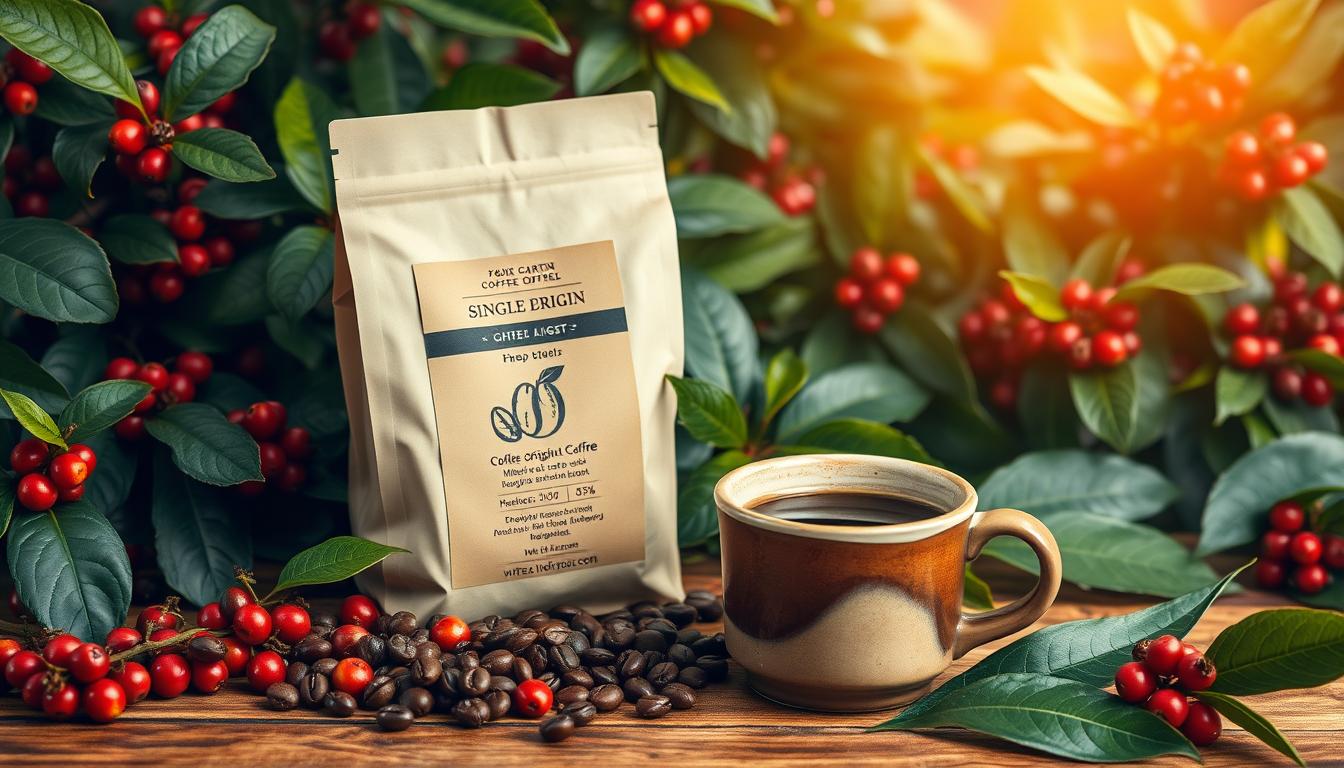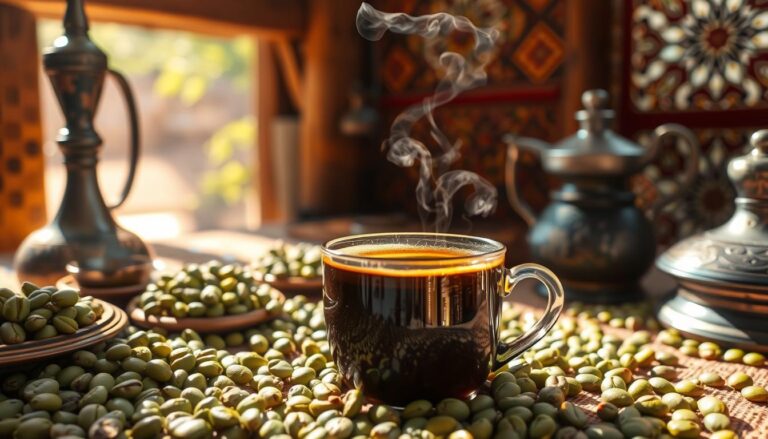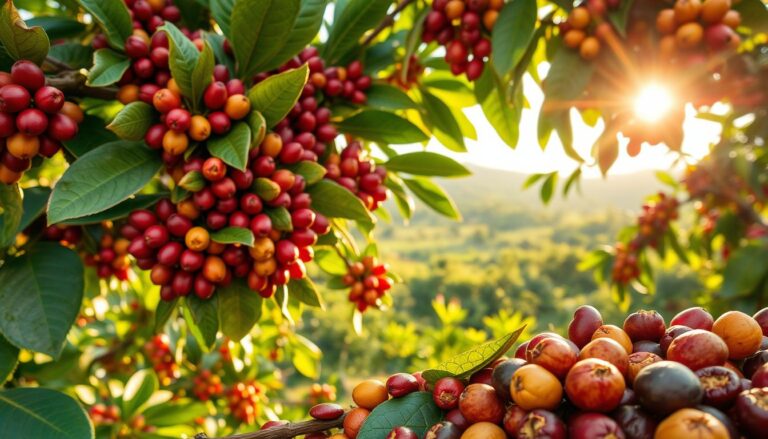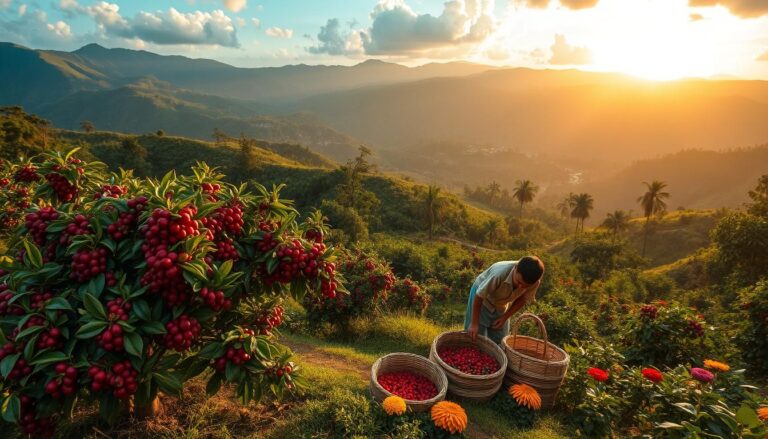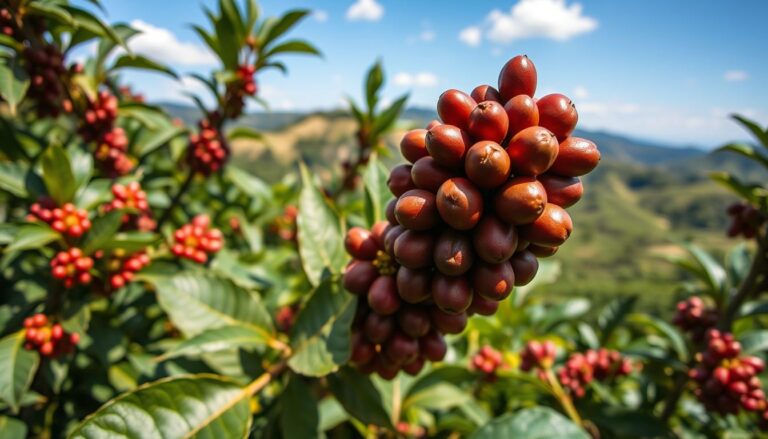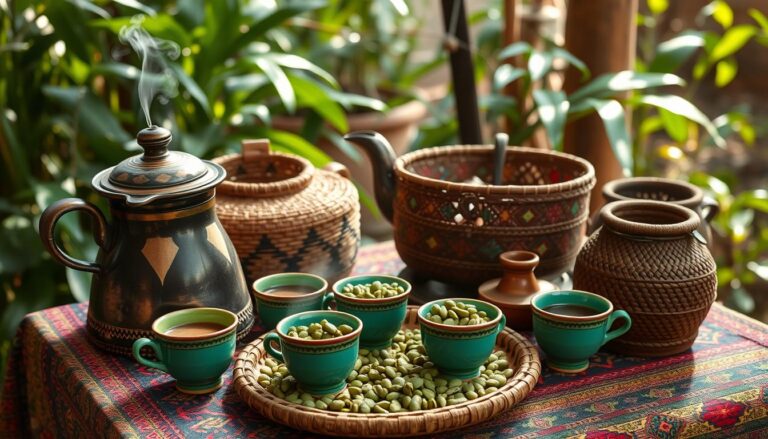Did you know the global specialty coffee market is set to hit $83.5 billion by 2025? This huge growth is thanks to the growing love for single origin coffee. Made by skilled artisans and grown by expert farmers, single origin coffee is a unique treat. It highlights the special tastes and traits of certain places.
Specialty coffee shops and roasters lead this trend. They focus on bringing top-notch single origin coffees from all over. Every cup of single origin coffee is a proof of its pure and unique taste. It’s a journey for both coffee lovers and newcomers, promising to excite your senses and broaden your taste.
Key Takeaways
- Single origin coffee offers a unique and captivating taste experience crafted by passionate artisans and expert farmers.
- Specialty coffee shops and roasters are dedicated to sourcing and providing premium single origin coffees from exotic regions around the world.
- Each cup of single origin coffee showcases the purity and distinctiveness of handcrafted coffee, with flavors that cannot be replicated.
- Exploring the world of single origin coffee promises to delight your senses and expand your palate as a coffee connoisseur.
- The global specialty coffee market is expected to reach $83.5 billion by 2025, driven largely by the rising popularity of single origin coffee.
What Makes Single Origin Coffee Special
Explore the world of single origin coffee and discover its unique traits. These coffees are known for their specific growing region, climate, soil, altitude, and terroir. Each region brings its own taste, from the bright Andean beans to the rich Brazilian lowland varieties.
Coffee Bean Origins
Single origin coffee lets you taste the variety and care that farmers put into their work. By choosing beans from one place, coffee shops can offer consistent and true flavors. This focus on quality and origin makes every sip a journey of discovery.
The Impact of Geographic Location
- High-altitude Andean coffee: Bright and fruity
- Brazilian lowland coffee: Full-bodied and chocolatey
- African coffee: Floral and complex
- Indonesian coffee: Earthy and smooth
Quality Control and Sourcing Standards
Keeping single origin coffees true to their nature is a detailed task. Specialty roasters and baristas follow strict quality and sourcing standards. They track the beans to their source and monitor every step of roasting and brewing. This ensures each cup is a perfect reflection of the coffee’s unique character.
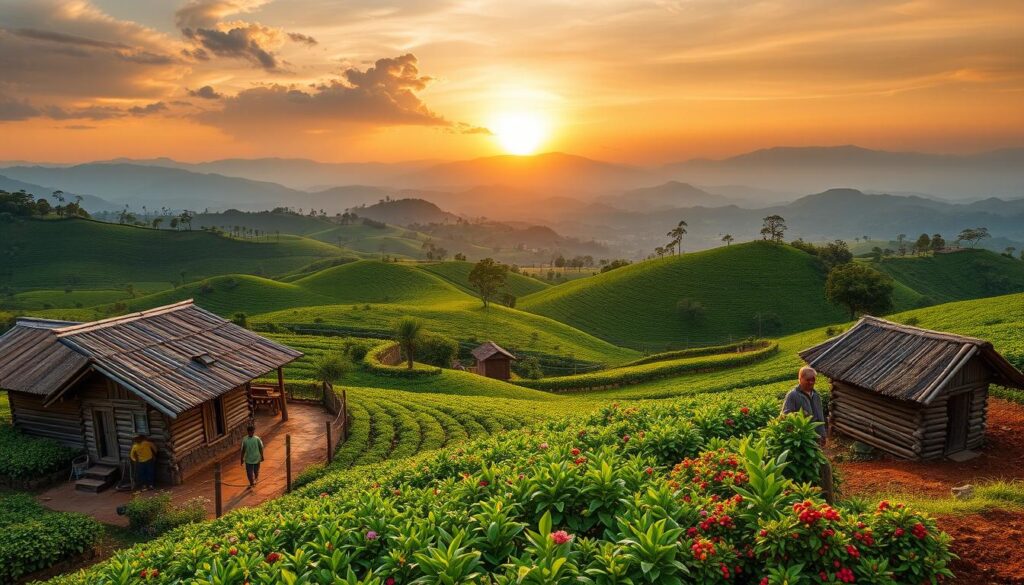
“Single origin coffee allows us to showcase the true character of each coffee region, honoring the hard work and dedication of the farmers who cultivate these exceptional beans.”
The Art of Coffee Terroir
Unlock the secrets of coffee flavor profiles and discover the captivating world of coffee terroir. This concept includes environmental factors that shape single-origin coffees. It covers climate, soil, altitude, and processing methods.
Every coffee-growing region has its own flavor notes. African coffees are bright, fruity, and floral. Central and South American coffees are chocolaty, nutty, and caramel-like. Asian coffees are earthy, fruity, and spicy.
Skilled roasters choose roast profiles to highlight each bean’s natural aromas and flavors. This brings out the unique taste of each coffee.
Embracing coffee cupping can deepen your understanding of a coffee’s flavor. It lets you notice differences in acidity, body, and intensity. By adjusting brewing methods, you can enhance the flavors in your coffee, making it a personal experience.
“The terroir of a coffee is the essence of its identity – a reflection of the land, climate, and care that shaped its unique character.”
Elevate your coffee journey by exploring coffee processing techniques. Try natural, washed, and honey processes to see how they affect flavor. Embrace the ritual and discover the art of coffee terroir, where every sip captures the essence of the land.
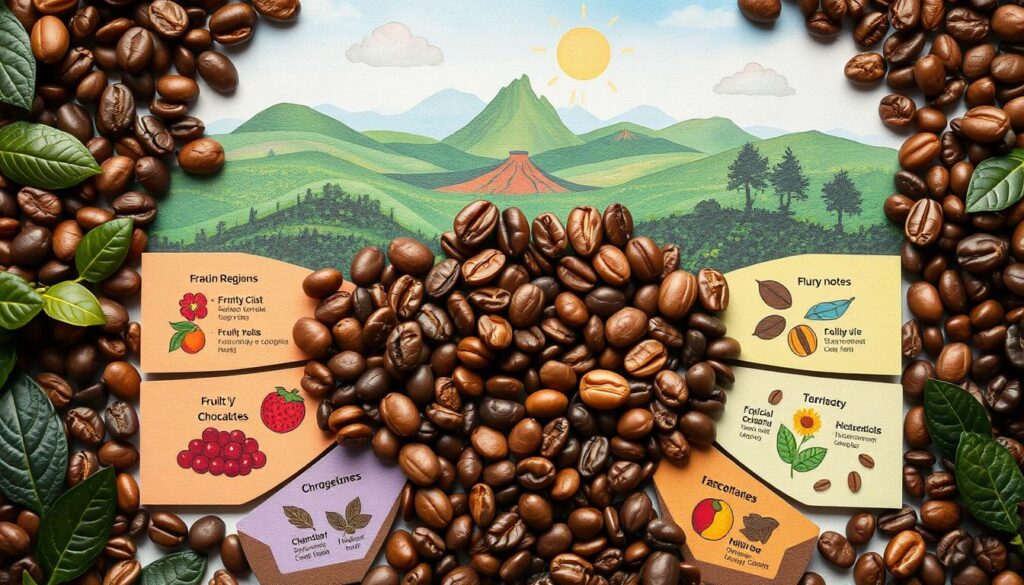
Exploring Global Coffee Growing Regions
Step into the world of coffee origins and discover the wide range of flavors. From the bright, fruity notes of African coffee to the rich, chocolatey tastes of Latin American blends, each region offers a unique experience.
African Coffee Characteristics
African coffees, like those from Ethiopia, Kenya, and Tanzania, are known for their vibrant flavors and high acidity. Ethiopian coffees often taste like blueberry, strawberry, and jasmine. Kenyan beans have a bold, intense taste with hints of blackcurrant and grapefruit. These coffees are a treat for those who love adventure.
Latin American Coffee Profiles
Head south to the lush coffee farms of Latin America. Here, you’ll find the famous Colombian and Guatemalan beans. Colombian coffee is known for its balanced flavor, mild acidity, and sweet nuttiness. Guatemalan coffee, on the other hand, is robust and chocolatey with a citrusy finish.
Asian Coffee Distinctions
Travel to Asia, and you’ll find unique coffees like those from Indonesia. Sumatran coffee, for example, has a full-bodied taste with low acidity. It’s known for its earthy, herbal flavors and a hint of spice. These coffees are sure to amaze you with their unique body and taste.
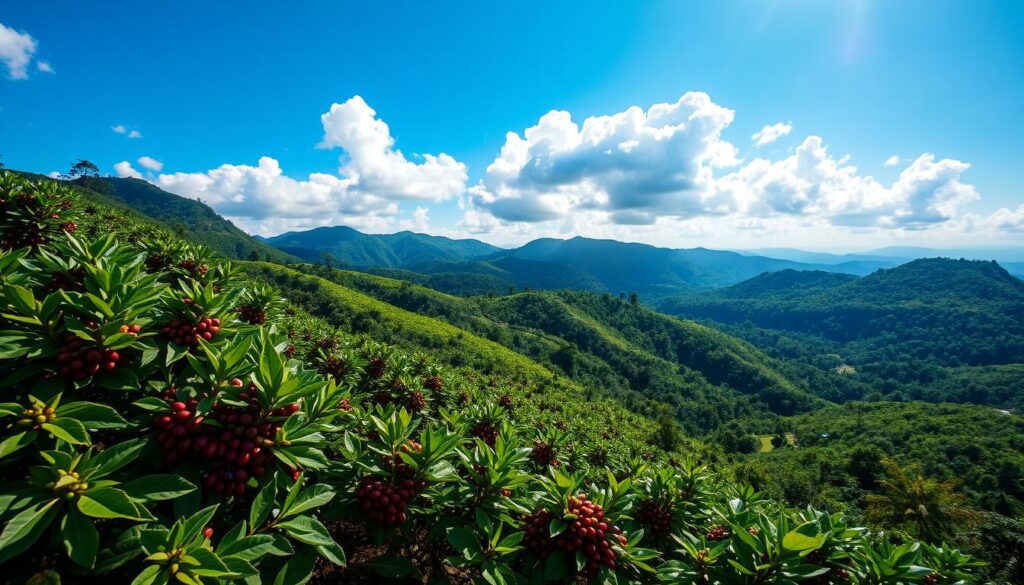
“Each coffee-growing region has its own distinct terroir, influencing the flavors and characteristics of the beans. Exploring these global origins is a journey of discovery for any true coffee enthusiast.”
The Journey from Farm to Cup
The quest for top-notch single-origin coffee starts with hard work by coffee farmers. These skilled farmers nurture their crops with care. They pick each bean by hand when it’s perfectly ripe.
The way coffee is processed, like natural, washed, or honey, greatly affects its taste. This step is key to the coffee’s flavor.
Specialty coffee roasters and shops team up with farmers for quality and sustainability. This approach offers a great taste and helps local communities. It also makes the coffee supply chain more open.
“Every step from farm to cup is done with intention, focusing on quality and craftsmanship.”
Ethical coffee sourcing and green farming are core to the single-origin coffee movement. This focus ensures farmers get fair pay. It also helps communities grow and keeps coffee production eco-friendly.
The path of single-origin coffee, from plantations to your cup, shows the dedication of coffee makers. Start this tasty journey and find out what makes your coffee so special.
Mastering Single Origin Coffee Brewing
To brew the perfect single origin coffee, focus on several key areas. These include the right brewing equipment, water temperature, and grind size. Understanding these elements helps bring out the unique flavors of your coffee beans.
Essential Brewing Equipment
There are many coffee equipment options to choose from. Pour-over setups cost between $20 and $100 and offer a clean taste. French presses, priced from $15 to $50, give a full-bodied coffee with oils and fine particles.
Espresso lovers can find machines from $100 for beginners to thousands for top models. These machines need precision and practice to use well.
Water Temperature and Timing
The best brewing temperature is between 195°F and 205°F. This ensures the water extracts the coffee’s oils and flavors without burning them. Start with a 1:16 coffee-to-water ratio, adjusting to taste.
Grind Size Recommendations
- Coarse grind for French press
- Medium grind for pour-over
- Fine grind for espresso
The grind size greatly affects your coffee’s taste. Try different grind settings to match your brewing method and coffee beans.
“The key to unlocking the pure, unadulterated flavors of single origin coffee lies in mastering the brewing process.”
Focus on these key factors to brew an amazing single origin coffee. Experiment and adjust to find your perfect brewing method.
Choosing Your Perfect Single Origin Coffee
Start your journey into specialty coffee by finding your favorite single origin coffee. Visit specialty coffee shops that have a great selection of single origin beans. Talk to the baristas to learn about the coffee’s origin, taste, and how to brew it.
Online coffee roasters like Blue Bottle Coffee have many single origin coffees to try. Think about the roast level, how it was processed, and its flavor when picking your coffee. Try different origins to find new favorites and enjoy your coffee tasting adventure.
- Look for specialty coffee shops that focus on single origin beans
- Talk to baristas to learn about each coffee’s unique qualities
- Check out online coffee roasters for a big selection of single origin coffees
- Think about roast level, processing, and flavor when choosing your coffee
- Try different origins to expand your coffee taste
“Single origin coffees offer a consistent flavor profile due to using beans from the same location, providing a well-balanced and distinct coffee experience for consumers.”
Finding your perfect single origin coffee is a fun journey. With help from coffee experts and a desire to explore, you’ll discover unique flavors and aromas. This will make your coffee experience even better.
Conclusion
Exploring single origin coffee leads to a unique coffee adventure. You’ll learn about the special tastes and qualities of coffee from different places. Each cup, whether it’s the fruity notes of Ethiopian coffee or the sweet hints of Colombian Arabica, takes you on a journey.
Learning to brew and find top-notch single origin coffee beans can make your daily coffee better. Enjoy the unique tastes from around the world, one cup at a time. This journey is full of flavors and experiences.
Whether you love coffee or are just starting, single origin coffee is waiting for you. Discover the secrets of coffee’s place of origin and the special flavors it offers. Dive into the world of single origin coffee and make your coffee time even more special.

